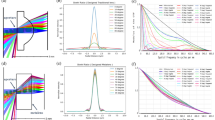Abstract
A tolerance allocation and auto alignment algorithm for the optical head of the near-field recoding (NFR) system are presented. The optical head of the NFR system consists of a solid immersion lens (SIL) and an objective lens (OL). The effects of assembling and manufacturing tolerances of SIL and OL are simulated using CODE V. These analyses show that the tolerances are very tight. So we proposed to move the collimate lens (CL) back and forth to compensate and control these tolerances, especially in the optical axis direction. Also, we allocate the compound tolerance of decenter and tilt motions of the SIL and OL using the worst On worst analysis (WOW) model. In addition, to align SIL and OL under these tolerances, we propose an auto alignment algorithm between SIL and OL. The simulation results of the alignment algorithm are compared with the experimental results.
Similar content being viewed by others
References
Betzig E, Trautman JK, Wolfe R , Gyorgy EM (1992) Near-field magneto-optics and high density data storage. Appl Phys Lett 61:142–144
Terris BD, Mamin HJ, Rugar D (1996) Near-field optical storage. Appl Phys Lett 68:141–143
Terris BD, Mamin HJ, Rugar D, Studenmund WR, Kino GS (1994) Near-field optical data storage using solid immersion lens. Appl Phys Lett 65:388–390
Kojima N, Mizuno T, Hitosugi T, Kawashima A, Watanabe K (2001) A practical fabrication of an optical flying head for a near-field recording system. Proc SPIE (ODS2001) 4342:271–273
Mizuno T, Hitosugi T, Kojima NDK, Watanabe K (2001) An optical flying head for a near-field recording system. Proc SPIE 4342:268–270
Mansfield SM, Kino GS (1990) Solid immersion microscope. Appl Phys Lett 57:2615–2616
Mansfield SM, Studenmund WR, Kino GS, Osato K (1993) High numerical aperture lens system for optical storage. Opt Lett 18:305–307
Hendriks BHW (1998) Optical tolerance of an actively tilted high-numerical-aperture two-lens objective for optical recording. Appl Opt 37:8195–8205
Bartlett CL, Kay D, Mansuripur M (1997) Computer simulations of effects of disk tilt and lens tilt on push-pull tracking error signal in an optical dist drive. Appl Opt 36:8467–8473
Optical Research Associates (2003) CODE V. http://www.opticalres.com. Cited 13 November 2003
Author information
Authors and Affiliations
Rights and permissions
About this article
Cite this article
Lee, JH., Gweon, DG., Jin, DK. et al. Tolerance allocation and auto alignment algorithm of focusing unit for near field recording system. Int J Adv Manuf Technol 29, 1041–1049 (2006). https://doi.org/10.1007/s00170-004-2141-4
Received:
Accepted:
Published:
Issue Date:
DOI: https://doi.org/10.1007/s00170-004-2141-4




